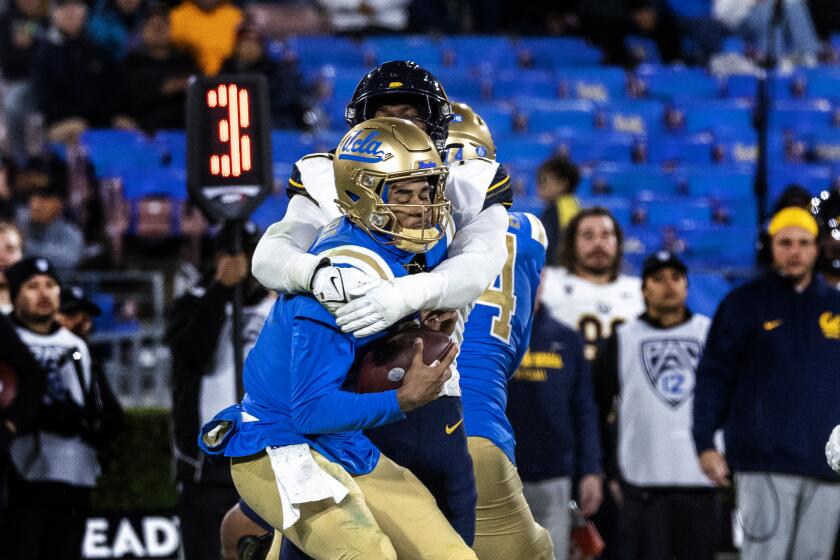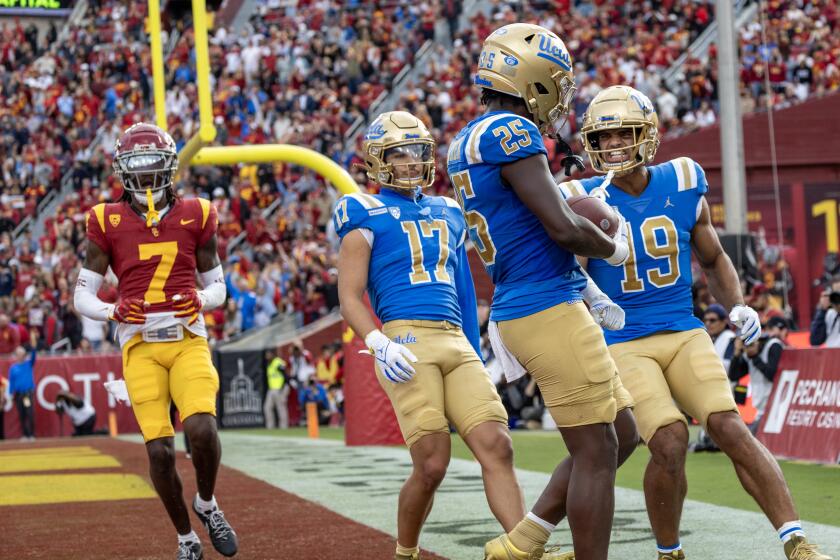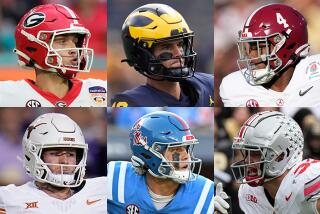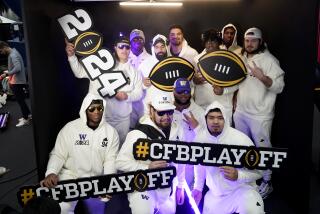Mourning the death of the best regular season in sports — college football’s
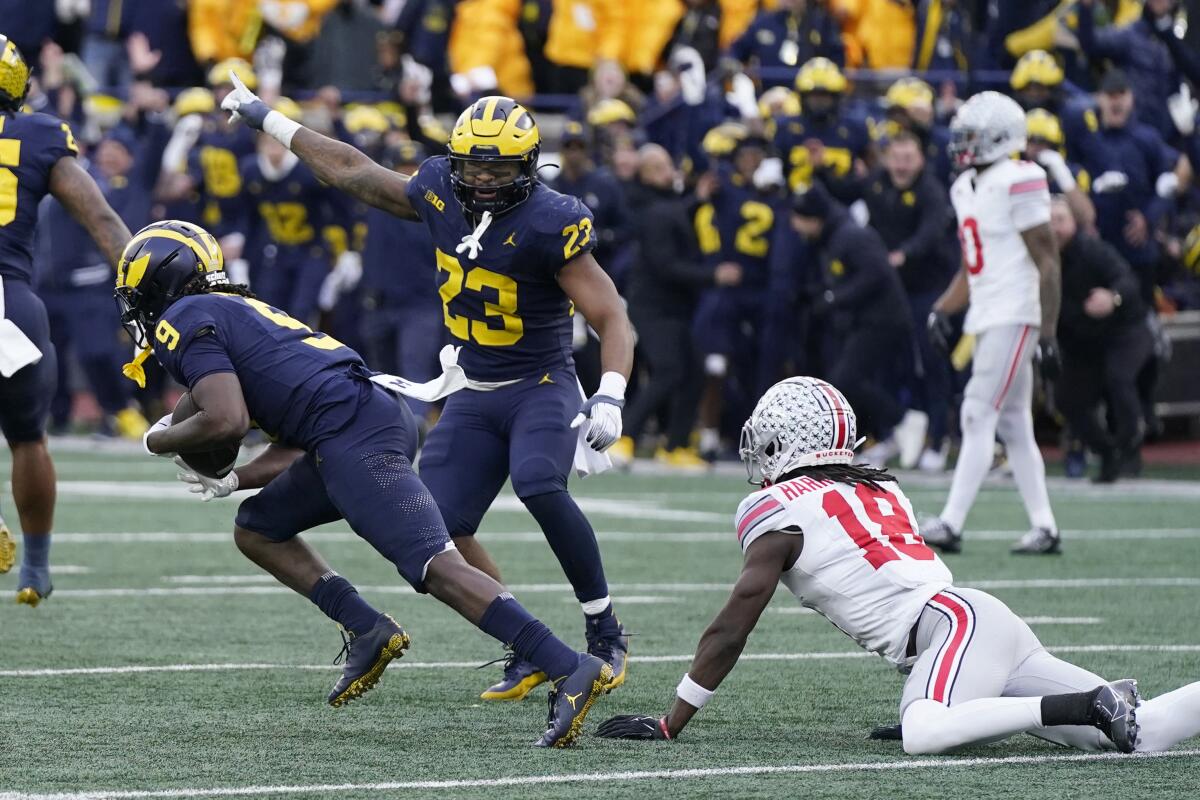
- Share via
In America’s two greatest college football rivalry games, a last-minute pass spun through the autumn air, carrying with it the fortunes and fates of iconic institutions.
In Ann Arbor, Mich., 110,000-plus held their collective breath as Ohio State quarterback Kyle McCord’s throw aimed toward the best wide receiver in the country seemed likely to be one more dart putting the Buckeyes in position for a winning touchdown. If Ohio State scored on this drive, it would end all talk of head coach Ryan Day not being fit to beat Michigan, and the Buckeyes would be headed for the No. 1 spot in the College Football Playoff rankings. For Michigan, a loss would have given the masses all the proof they needed to belittle the Wolverines’ back-to-back Big Ten championships and label Jim Harbaugh’s program forever as a fraud. It could be reasonably argued that stakes have never risen higher in the history of The Game.
In Auburn, Ala., everything was coming apart for Nick Saban. The Crimson Tide trailed 24-20 to an Auburn team that was pummeled a week earlier on the same field by New Mexico State. A botched snap and a penalty had pushed Alabama to the Auburn 31-yard line, where it faced an unimaginable fourth and goal. But the Tigers rushed only three players, giving quarterback Jalen Milroe time to pick a spot and heave his miracle. He chose the back left corner of the end zone, where somehow his receiver had found one-on-one coverage. There wasn’t nearly as much on the line as the classic in Ann Arbor except Alabama’s chances to play its way into the CFP next week against Georgia — and 365 days worth of “War Eagle” being chanted in the faces of Alabama fans.
Marvin Harrison Jr. looked to be open to McCord, who was pressured and just had to trust the fates were on the Buckeyes’ side, as they had been so often during the last two decades of this rivalry. But Michigan safety Rod Moore was lurking and leaped into Harrison’s air space, cradling the ball as he fell to the Big House turf to clinch a 30-24 win.
Isaiah Bond, a much lesser-known receiver than Harrison, owned his fly zone in Jordan-Hare Stadium, catching Milroe’s perfectly thrown pass before getting his feet down, saving the Crimson Tide’s season and breaking tens of thousands of blue-and-orange hearts.
Saturday’s rivalry pairing was as good as it gets. It was a fitting way for college football’s regular season as we’ve always known it — as the best (most gut-wrenching) in all of sports — to exit the stage. It was also a sad reminder of all that’s being lost as 2023 turns to 2024.
UCLA never recovered after losing Ethan Garbers to injury in the first quarter of the Bruins’ 33-7 loss to Cal on Saturday at the Rose Bowl.
A year from now, if the Wolverines and Buckeyes meet as 11-0 teams for the third straight season, which is unlikely due to how much tougher their schedules will be in the new Big Ten, the loser would not feel the same level of devastation that Day described after this one. The teams would potentially meet again one week later in the Big Ten championship game, with the conference ditching divisions. Even if there was not a rematch, the loser would still make the new 12-team playoff.
A year from now, if Alabama’s miracle wasn’t granted, it possibly would stillbe invited to the 12-team playoff with a 10-2 record.
A year from now, Washington’s last-second field goal to beat Washington State and preserve its unbeaten record would not feel as existential. The Huskies would still be in position for the expanded playoff, win or lose. Heck, the Apple Cup won’t even be a conference game.
Between the 12-team playoff and the end of the Pac-12, college football will never be the same. Both titanic shifts came for the same reason: the sport is the second-most compelling TV show in the country, behind the NFL, and the networks want more high-end episodes.
What the executives probably haven’t thought through is they’re trading regular-season matchups such as Michigan-Ohio State the last three years that feel end-of-times level apocalyptic for eight more playoff games that might or might not be much better than some of the dud semifinals we’ve witnessed during the nine years of the four-team format.
As a Michigan graduate, I’ve spent the last 20 years knowing that no matter what the Wolverines did the first 11 games, everything comes down to the Saturday after Thanksgiving. In some ways, the looming terror of the annual Ohio State beatdown stripped some joy from the journey that should have been tapped. The Game with those stakes has probably not been good for anybody’s emotional, mental or even physical health.
Even with the change in conferences next season, the Bruins will still have a scheduled game after playing the Trojans. That has to end.
Beyond that, these changes are potentially going to be great for emergent programs such as Missouri, which is 10-2 and would have earned an at-large spot in a 12-team playoff this season. The programs that don’t consider a top-25 ranking as a birthright will have the ability to tell recruits with an actual straight face that you don’t have to go to Alabama or Georgia to make the playoff anymore. If those programs have a well-funded donor collective, they are very much in position to cause some disruption at the top.
College football’s full acceptance of itself as a hit TV show over the last few years will also lead to programs sharing that revenue with the players — and sooner rather than later. When Texas A&M can pay its failed head coach $76 million to go away, and when Pac-12 presidents were willing to butcher a century’s worth of West Coast Saturday tradition, all pretense of this being an amateur sport has disappeared.
I’ll miss days like Saturday, but I’m going to choose to believe these positives will outweigh the negatives, because with TV suits calling the shots, nobody else has a say anyway.
Playoff jockeying
The only team that exited the playoff picture (barring some very unexpected conference championship results) on Saturday was Ohio State.
Florida State backup quarterback Tate Rodemaker’s gutsy performance on the road at Florida kept the Seminoles alive for one more week. If Florida State beats Louisville in the ACC championship game, is the CFP committee really going to keep out an unbeaten power conference champion? Doubtful. Texas and Alabama fans will be rooting for the Cardinals on Saturday.
Michigan is in with a win over Iowa. Georgia is in with a win over Alabama. I believe the Pac-12 championship winner between Washington and Oregon on Friday night is in. Then it’s Florida State or Texas, which has Oklahoma State in the Big 12 title game.
If Alabama upsets Georgia, that’s when things will get interesting. It seems unfathomable the committee could keep out a 12-1 SEC champion with the best win of the season. So then you’re looking at Michigan, Washington/Oregon, Alabama and, once again, Florida State or Texas. But it isn’t that simple, considering Texas beat Alabama in Tuscaloosa.
Does the committee then feel forced to push out Florida State, with the argument the Seminoles aren’t the same team without Jordan Travis?
The best TV show would be Michigan, the Pac-12 champion, Alabama and Texas, all of which have their starting quarterback available.
More to Read
Go beyond the scoreboard
Get the latest on L.A.'s teams in the daily Sports Report newsletter.
You may occasionally receive promotional content from the Los Angeles Times.

